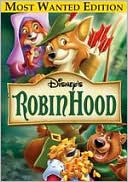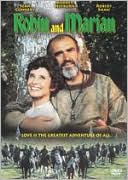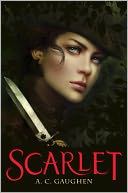
 Robin Hood is one of the best-loved (and most often re-told) English legends, probably just behind the King Arthur stories in the number of times it’s been re-done and re-interpreted. And examined by everyone from Disney to Sean Connery. Cartoon to pathos.
Robin Hood is one of the best-loved (and most often re-told) English legends, probably just behind the King Arthur stories in the number of times it’s been re-done and re-interpreted. And examined by everyone from Disney to Sean Connery. Cartoon to pathos.
 Scarlet by A. G. Gaughen is a slightly different take on Robin Hood and his so-called “Merry Men”, who are certainly not merry in this re-telling of the tale.
Scarlet by A. G. Gaughen is a slightly different take on Robin Hood and his so-called “Merry Men”, who are certainly not merry in this re-telling of the tale.
In Gaughen’s version, “Will” Scarlet is known as “Scar” for the scar on her cheek. The change twists the tale. Scar is female, passing as male for her own safety. The story of how this young woman came to be hiding as a boy in the midst of a band of outlaws in Nottinghamshire makes something new out of an otherwise familiar legend.
We all know the Robin Hood story. Robin, Earl of Locksley returned from the Crusades after his father’s death. He should have inherited the Earldom. Instead he became an outlaw, a hero, and eventually a legend.
In this story, Robin is the outlaw Earl, still trying to protect his people. The difference is Scarlet, or Scar. All the rest of the familiar players in the drama are present and accounted for.
But Scar is a confused young woman. She hides her nature from the villagers in Nottinghamshire, but Robin and the band know that she is female. No one knows her real identity. And all of her deceptions begin to unravel when the Sheriff hires a thief-taker named Guy of Gisbourne, and Scar is so petrified that she freezes at the mention of his name.
Although the outlaw band do rob the rich to keep the villagers fed and help them pay their taxes, Scar truly is a thief. She loves bright shiny objects and steals for the challenge of it. But she never keeps what she steals. Scar sells everything she takes to help keep the village ahead of the taxman. She doesn’t even eat enough, because she knows someone else, anyone else, is more deserving than she.
Robin worries for her, and has from the day he met her in London when she tried to pick his pocket, thinking he was still a Lord. He sees that something terrible preys on her, but doesn’t know what it is until Gisbourne comes to wreck the delicate balance of their corner of the world.
Scar’s unknown past has become a danger to the outlaw band’s present. But her secrets reveal that Robin has never known anything of who she really was, or is. Once he finds out, can he live with the knowledge? No matter how high the cost?
Escape Rating B-: I have mixed reactions to this book. On the one hand, the concept of changing one of the characters from male to female was a very neat idea. That was terrific. On the other hand, I did figure out what Scarlet’s real identity was pretty early on, so if I was supposed to be fooled, I wasn’t.
The author I think was trying to write Scarlet’s character as using a sort of street vernacular to show that she was not a lady. Even in Scarlet’s own thoughts, her use of language was not as formal as the “upper classes”. When it’s used for Scarlet’s thoughts as opposed to speech, it can be annoying to read. It is part of her secret, but I wonder if she would think that way. Speak, yes–think, I’m not so sure.
The Robin Hood legend has been re-told so often that it is hard to make it original. For this reader, this version wasn’t quite original enough. Scarlet conceals her female nature so effectively, she often succeeds in hiding it from herself. Where it would have been fascinating to have a young woman’s reactions to being a female in a band of men, most of the issue of Scarlet being female is handled by her suddenly becoming the object of jealousy between two of the band, and her being ill-equipped to cope with the problem.

